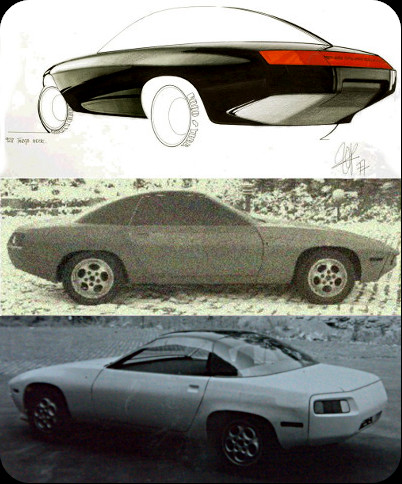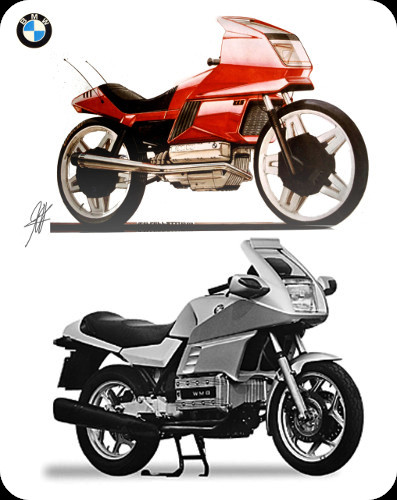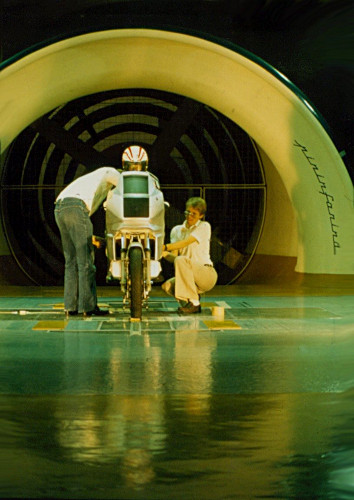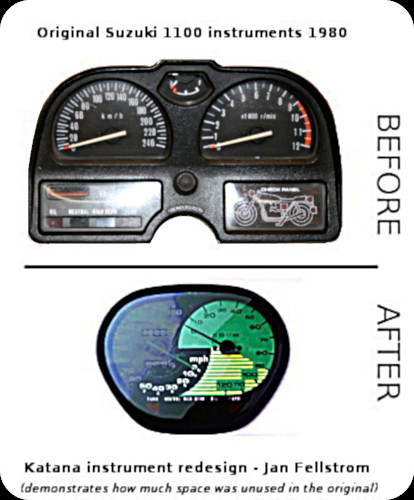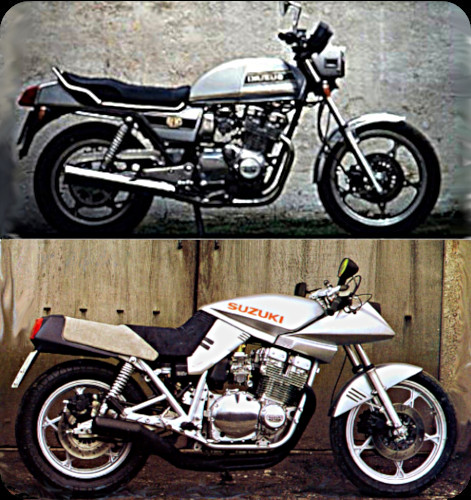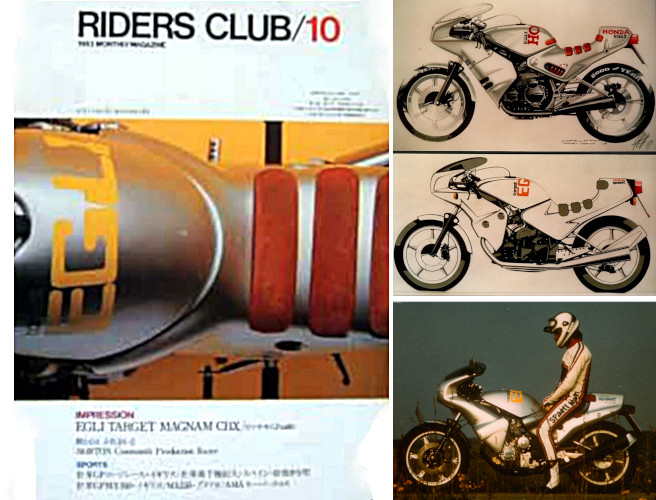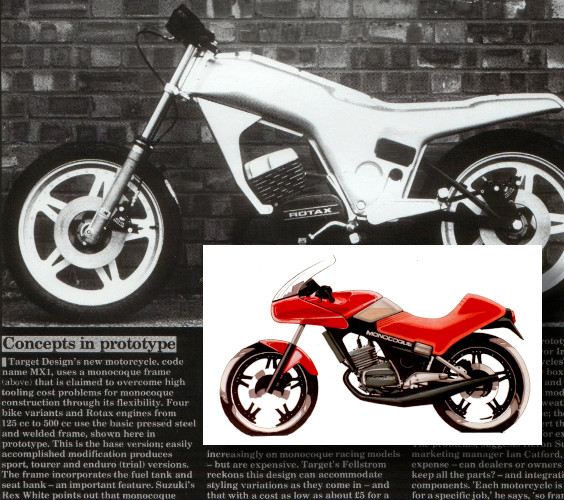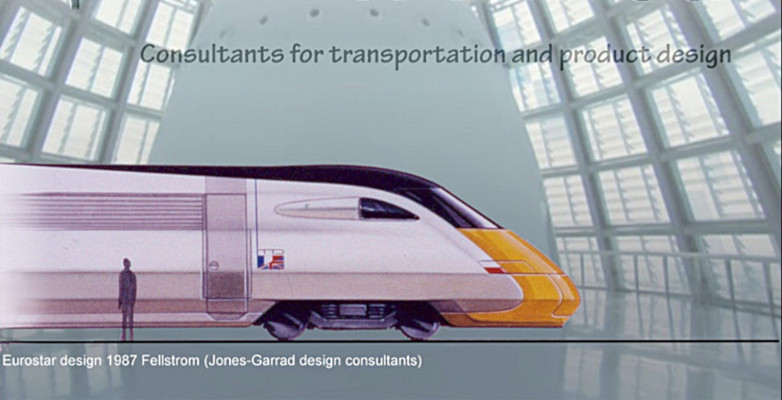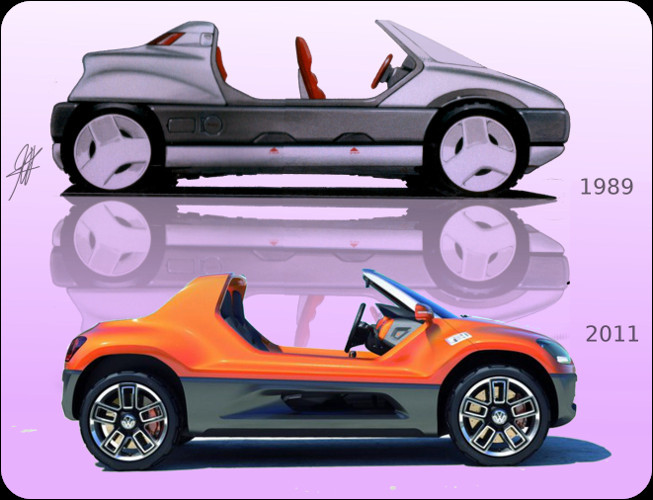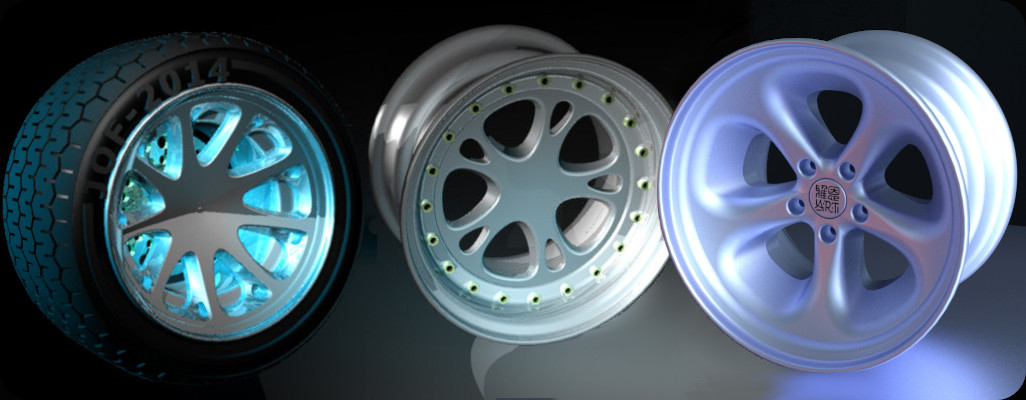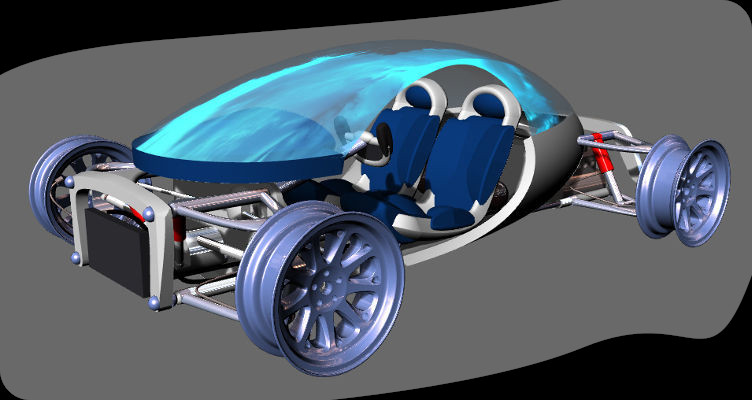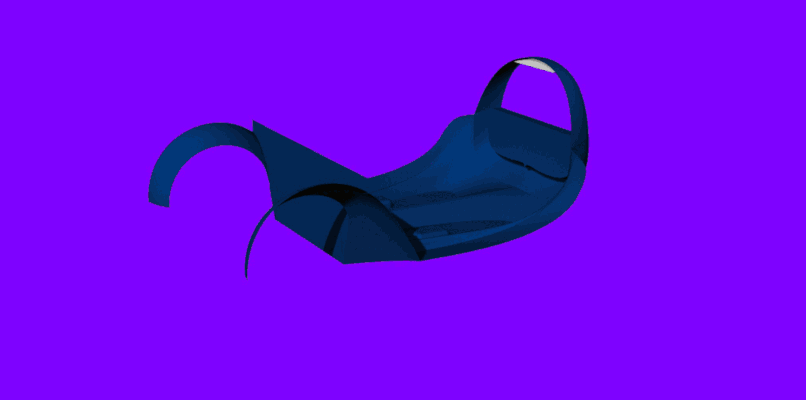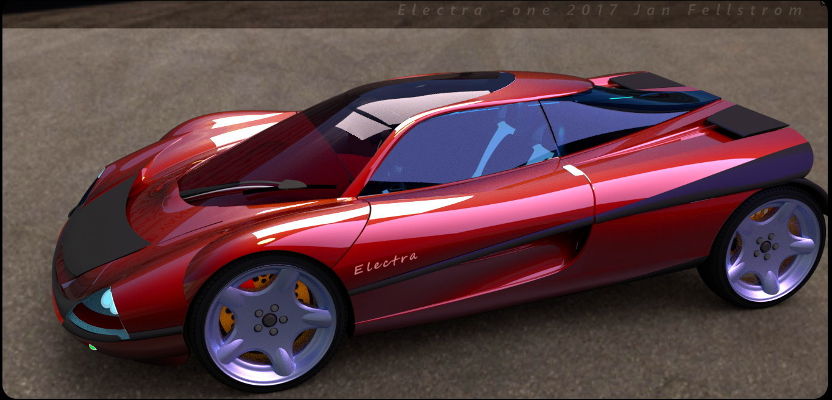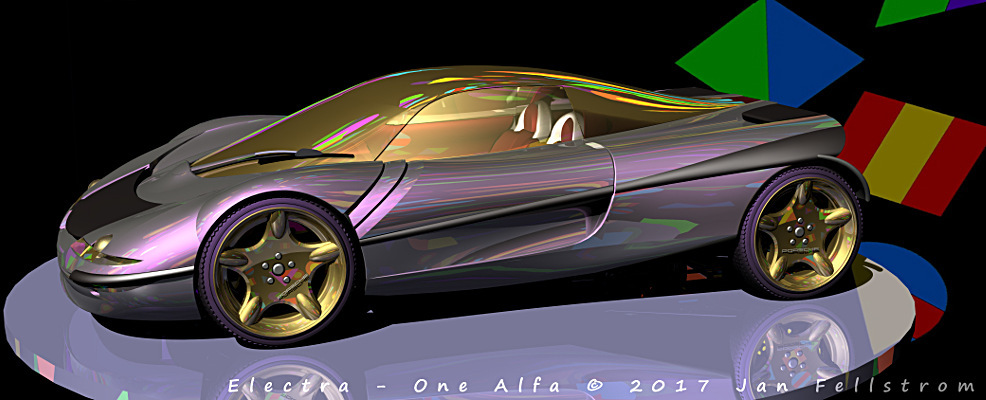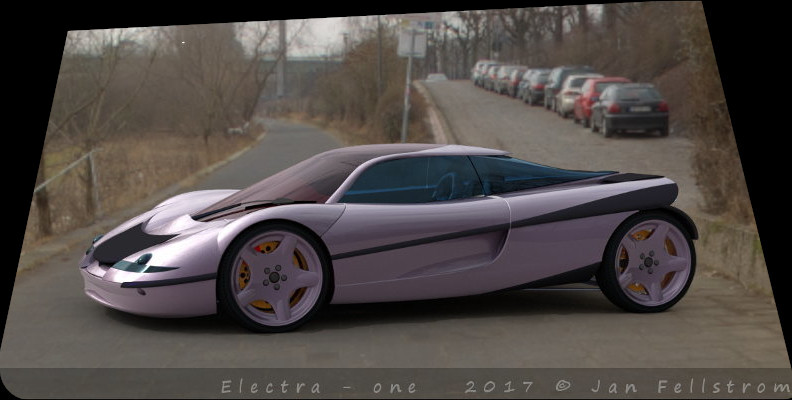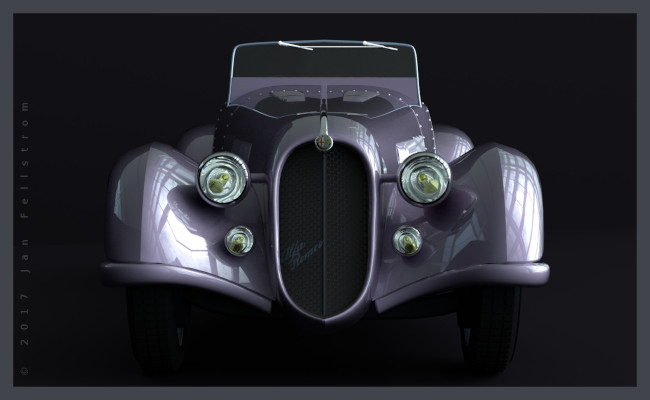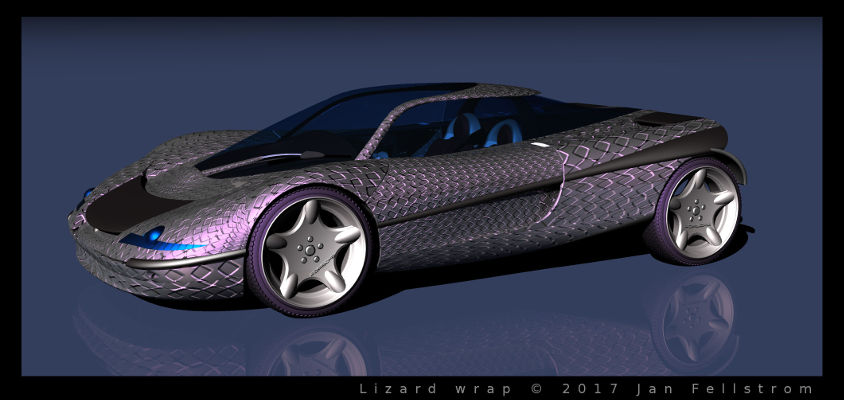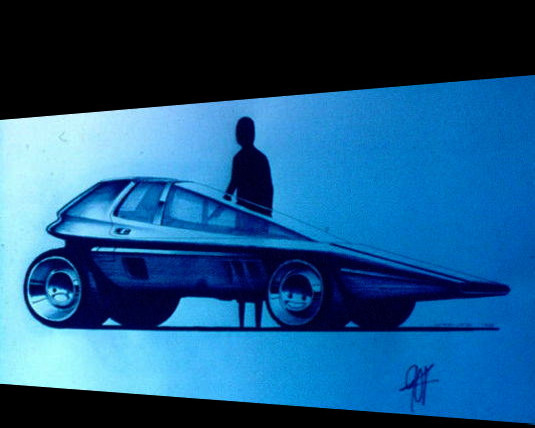

College years 1969 - 1976
 An early car design sketch (ca.1970). Black felt-tip marker pen on cartridge paper. The cartridge paper soaked up the ink so that as the pen dried out it gave a faded effect. It usually required one pen per drawing.
An early car design sketch (ca.1970). Black felt-tip marker pen on cartridge paper. The cartridge paper soaked up the ink so that as the pen dried out it gave a faded effect. It usually required one pen per drawing.
During the 1970s, while on my BA industrial design course, I entered the Daily Telegraph British Styling Competition and one year my unusual but rather ugly design was one of 22 chosen for final judging. It was a fiercely fought competition as if you won they built the car, so it attracted many professional designers.
After almost 7 years of Art & Design education I found myself working as a car designer in 1976 for Porsche in Germany. Initially it was a 3km walk to work if my lift was unavailable and sometimes that meant tramping knee deep in snow. Approaching the R&D centre I was often greeted by the growling sounds of Le Mans Porsches being tested on a track that encircled the design centre. I had joined the world of the 'Martini people' (Martini sponsored Porsche racing at that time and a Martini TV advert depicted the 'jetset' sipping Martinis under Martini umbrellas.)


Style Porsche 1976 - 1977
 Porsche 928 Targa (1977) original concept sketch (top), 1:1 clay model (middle) and GRP mockup (bottom).
Porsche 928 Targa (1977) original concept sketch (top), 1:1 clay model (middle) and GRP mockup (bottom).
My first task at Porsche was to sketch a facelift for an Iranian Hillman Hunter (originally a cheap British saloon car). My boss insisted it should have a Mercedes grill. This was not the Porsche dream job I had imagined. However things did improve slowly with smaller Porsche projects until eventually I was working on the 928 Targa project. I also designed the 924 turbo wheels, but my boss, much to my dismay, insisted they should be like large BBS wheels, which he pointed out to me on a car in the staff car park. There was a brief period working on an exciting 928 mid-engined Le Mans racing car but that project soon faded away.
The lack of any other meaningful work and long periods of boredom forced me eventually to seek work elsewhere. After almost 2 years with Porsche I departed for BMW.


BMW Motorcycle design 1977 - 1979
 BMW K100RS - Original sketch (above) and production bike ca.1978.
BMW K100RS - Original sketch (above) and production bike ca.1978.
BMW motorcycle design proved to be much more exciting than Porsche with various motorcycle projects that included helmets, instruments and panniers. Projects were completed faster and design combined interior with exterior together with product design. Style Porsche had been an international team of around 30 designers, modelers and engineers, whereas BMW motorbike design team consisted of only 10 people who were mostly German.
My main work was on the K100 series motorbikes after the original K-project had been scrapped soon after my arrival. I had a joint patent on the K100RS screen aerofoil design, which was tested in Pininfarina's Turin wind tunnel. The K100RS with its new water-cooled engine proved to be a very successful design that lasted almost ten years before it was finally replaced.


BMW Motorcycle design 1977 - 1979
 Wind tunnel testing BMW K100RS at Pininfarina, Turin, Italy (ca.1979)
Wind tunnel testing BMW K100RS at Pininfarina, Turin, Italy (ca.1979)
Although motorcycle projects could be completed quicker than car projects, the models were much more complicated due to technical components like motor and suspension being visible. That often required a mix of modeling techniques and materials with complex armatures to hold everything together. We did a lot of testing in Pininfarina's wind tunnel to reduce the drag and to improve rider comfort, even replacing the dummy rider with ourselves on occasions to gain real insight.
In 1979 management decided to merge BMW Motorrad (GmbH) with BMW Cars (AG) and the new marketing management asked me to design 'chopper bikes'. Their decision caused a great deal of turmoil in the studio and I decided that it was time to look elsewhere as I was more interested in designing compact, lightweight motorbikes.


Target design 1979 - 1984
 BMW K-series 1:5 base model sketch featured in Car Styling magazine issue 73 in an article about Target design. This proposal for BMW was created during my time with Target design.
BMW K-series 1:5 base model sketch featured in Car Styling magazine issue 73 in an article about Target design. This proposal for BMW was created during my time with Target design.
My former BMW boss tempted me away from BMW with a Suzuki project and after much negotiating, together with an ex Porsche/BMW colleague, we formed Target Design in 1979. We worked fast and efficiently under difficult conditions. It was one of the coldest winters on record in Munich and freezing in our draughty old mill studio on the edge of Lake Ammersee. Heating consisted of endlessly stoking a kachelofen (bricket stove) all day long and that also continued for me at home when I returned in the evenings.
Nevertheless, despite working for the most part in our ski clothes we created designs that became classics, largely due to our common design philosophy of 'Less is more' and attention to aerodynamics and ergonomics.


Target design 1979 - 1984
 Target-design: The original design studio, an old mill beside Lake Ammersee in Germany, pictured (far left) during the first Suzuki presentation of the Katana 650 (ED-1).
Target-design: The original design studio, an old mill beside Lake Ammersee in Germany, pictured (far left) during the first Suzuki presentation of the Katana 650 (ED-1).
Some months later we created the more radical and famous Katana 1100 (ED-2) in clay and GRP, original sketches & models (ca.1980) (centre). Suzuki management had been so happy with the ED1 model they gave us an open brief for ED2, which accounted for the radical design.
We experimented modeling the ED-1 model in PU foam, which was then covered in a thin skin of 'filler' plaster before being painted. However changes to the shape were difficult to make and it was also easily damaged, so we reverted back to conventional clay modeling for ED-2.


Target design 1979 - 1984
 When creative freedom is allowed the results can be surprising ... (ED-2) instruments.
When creative freedom is allowed the results can be surprising ... (ED-2) instruments.
Above the old 1979 Suzuki 1100 instruments and below the slimmed down Katana 1100 instrument. Both designs contained the same technical components but by redesigning the instrument graphics and rearanging the internal components it was possible to significantly reduce the physical size and quantity of plastic used.
Trimming away every last gram of unnecessary material was always our aim in an effort to reduce costs, weight and size. Chopper motorcycles on the other hand tend towards the exact opposite philosophy. I can appreciate many of the exotic one-off hand-built choppers seen particularly in America, many could be called works of art, but as production bikes I felt they were often prime examples of bad design.


Target design 1979 - 1984
 The 1979 production Suzuki GSX 1100 (top) and the 1980 Suzuki Katana design (ED-2) GRP model (below).
The 1979 production Suzuki GSX 1100 (top) and the 1980 Suzuki Katana design (ED-2) GRP model (below).
The Katana design was dramatically different to anything seen before and influenced the shape and direction of future motorcycle designs. By considering aerodynamics, ergonomics and economics it was possible to create a completely new look that was both practical and exciting.
Although the Suzuki project was the first major contract for Target design, we were soon working on a number of other projects that included a Castrol bicycle with a SMC plastic frame *, an Audi interior and other smaller projects. In fact our small team was quickly overwhelmed with projects and the lack of adequate facilities and personnel, plus impossible deadlines eventually led to a crisis. The 3-man team was reduced to a 2-man team fighting legal battles.
*Thankfully that project died. It is hard to imagine the impact a non-recyclable plastic frame would have had on the environment had it taken off. It shows how important it is for designers to be aware of such things.


Target design 1979 - 1984
 Target - Egli CBX: featured on the 'Riders club' cover, a Japanese magazine (far left). My original 1:5 sketch (top), 1:1 tape drawing (middle) and the bike with rider.
Target - Egli CBX: featured on the 'Riders club' cover, a Japanese magazine (far left). My original 1:5 sketch (top), 1:1 tape drawing (middle) and the bike with rider.
The Egli CBX was a joint venture between Target design and Egli, a well known Swiss motorcycle frame maker. The Honda 6-cylinder engine used for this project was in-line and air-cooled. The transverse engine layout made the bike very wide so that the engine was only just covered by the fairing. This project inspired the 'TÜV bügel' (MOT bar) now seen on many scooters and motorbikes. The bar hung off the rear wheel (see middle drwg. & photo) and was designed to get around a German legal requirement for the wheel to be covered 100mm above its centre line.
The unusual seat design, featured on the Riders Club magazine cover, was initially questioned by many involved in the project. However the seat strips proved to be very comfortable, particularly as unlike conventional seatbanks, usually made from smooth leather, this ribbed design held the rider in place under braking and acceleration. This allowed the rider to feel more relaxed, secure and in control.


Target design UK 1981 - 1984
 Target design UK Ltd - I worked briefly at Talbot Advanced design on the ECO2000 before forming Target Design UK Ltd. Cotton International - MX1 monocoque bike frame featured in 'Design' magazine (ca. 1984). The B/W photo shows the monocoque frame and Rotax engine minus bodywork and seat. Below a red sketch of the sports version.
Target design UK Ltd - I worked briefly at Talbot Advanced design on the ECO2000 before forming Target Design UK Ltd. Cotton International - MX1 monocoque bike frame featured in 'Design' magazine (ca. 1984). The B/W photo shows the monocoque frame and Rotax engine minus bodywork and seat. Below a red sketch of the sports version.
The MX1 grew out of a change in UK law for learner riders after the engine size was reduced to 125cc from 250cc. Two London entrepreneurs approached Target design UK about designing a 125cc motorcycle for this new market. A monocoque frame had many advantages but it did have some disadvantages. Tooling was expensive and design freedom was somewhat restricted. I believed a modular system could solve those problems. The final concept resulted in a monocoque frame that could support a range of 16 or more different models all using Rotax engines from 125cc to 500cc, with some minor modifications.
The very first prototype to hit the road, financed by a Liverpool development grant, was a surprising success. The frame was rigid enough and did not flex as feared and eventually it was presented on the BBC TV Money program by Valery Singleton.


Freelance 1984 - onward
 A preliminary design proposal for Jones-Garrard design consultants for the Eurostar train.
A preliminary design proposal for Jones-Garrard design consultants for the Eurostar train.
Jones-Garrard asked me to supply them with concept sketches for the new Eurostar train exterior while they were still in the initial stage of competing with other design consultancies in France and Britain to win the contract to design the train. They eventually won the contract to design the train exterior (1987).
I found it difficult running a design studio on my own with all the paperwork and bureaucracy involved, which left little time for my real interest, designing. So in 1984 I decided to close Target design UK and work freelance in future. I began teaching, designing and consulting throughout Europe. I worked on products for DCI in Japan (one design I proposed was a single handheld camera, very similar to today's smartphone cameras). Other work included Honda motorcycle and car projects. I also spent short periods as a designer/manager within Austin-Rover (UK), BMW Technik (Germany) and Peugeot (Paris), but once a freelancer it was difficult to adapt to being an employee again while experiencing the waste and inefficiency of large organisations and marketing's dominance on the direction products should take.


Freelance 1990 - onward
 Moke design (above ca.1989) originally a sketch for Eckard design (nka EDAG). Below a similar looking VW concept moke (ca.2011) which I came across.
Moke design (above ca.1989) originally a sketch for Eckard design (nka EDAG). Below a similar looking VW concept moke (ca.2011) which I came across.
During this period I worked on a variety of projects all over Europe. I helped set up the EDAG design studio after a period of working for SEAT in Barcelona. I was surprised at how similar my sketch looked to the VW project that I found on the Internet, but then EDAG was an international engineering company that worked closely with most German automotive companies.
I have to say that although my design proposal was done 20 years before the VW model, it still looks more modern in my view, no wonder that I decided to leave the car industry.


Freelance 2000 - onward to 3D modeling
 Wheels and tyre design exercises created in Rhino 3D. The tyre tread is taken from 70s race car tyres.
Wheels and tyre design exercises created in Rhino 3D. The tyre tread is taken from 70s race car tyres.
When I began my design career in the 1970s computers were virtually non-existent. They appeared in design studios during the 1980s and although I had tinkered on an early Amiga 500 (only 1mb memory! yet it could read text), creating designs on computers was still a long way off. Computers were mainly used for writing text and replacing noisy typewriters. Internet and mobile phones were still a distant dream. In fact the very idea of sitting behind a computer daily filled me with dread. However a new generation of designers soon began creating designs on computers and as the software improved so did the CG models.
I trained on Alias Wavefront initially but being old school I still preferred making pastel - marker drawings, while younger designers were churning out endless computer generated designs. As such I started late creating designs on computers and it was long after I was considered employable as a designer by the car industry and so it became more of a hobby.


Freelance 2010 - onward
 Gecko - An experimental concept for testing my Rhino 3D skills (ca.2015). A lightweight two-seater sportscar concept originally with a mid/rear mounted 5-cylinder Wankel engine and trans-axle with FWD.
Gecko - An experimental concept for testing my Rhino 3D skills (ca.2015). A lightweight two-seater sportscar concept originally with a mid/rear mounted 5-cylinder Wankel engine and trans-axle with FWD.
Over the years in the design industry I had been exposed to various 3D software but it was not until I began to learn Rhino 3D that I had finally found a program that really suited me. Most of my 3D skills were honed on this software and later Blender, which proved to be better for animation and rendering.
Rather than learning through exercises and being taught I preferred to create my own designs and then grapple with the software to make them happen. A philosophy of learning by doing, which I have always taught and stood by. It may be a slower process but the struggle involved always ensures that you never forget how to build, repair or make something and sometimes you may even find better solutions than those found in a manual.


Freelance 2010 - onward
 Lizard Duo - Based on the Gecko another exercise to practice my Rhino 3D skills (ca.2015).
Lizard Duo - Based on the Gecko another exercise to practice my Rhino 3D skills (ca.2015).
After trying numerous software programs for rendering I stumbled across Blender and began experimenting with animations. What is fascinating about the vast array of software programs today is how they can all be harnessed together to create impressive presentations for the Internet via YouTube and other platforms. It has cut out much of the expense, mess and inconvenience of previous techniques.
Now virtual animated 3D models can be viewed instantly anywhere in the world and image files emailed at the press of a button. This is taken for granted today but older generations will remember how things had to be posted by snail mail not so long ago and you might have flown halfway across the world just to view a model. Back in the 70s libraries or encyclopedias were the only source of information.


Freelance 2010 - onward
 Austin Sherline body shell - Rhino 3D (ca.2014).
Austin Sherline body shell - Rhino 3D (ca.2014).
My father owned several of these, one in two-tone green, which I particularly loved. The enormous chromed headlamps (not shown) always impressed me and only rarely seen on other cars, such as Rolls Royce.
In winter starting often required hand-cranking, not an easy task to perform. My father always ran the risk of a crank handle kick back injury as the rest of the family watched in suspense from the comfort of the leather upholstered interior.
It may have only been a cheap old Austin but to us it was like a Rolls Royce and perfect for taking our large family on summer vacations to Sweden. (In those days flying was only for VIPs and business travelers).


Freelance 2010 - onward
 Video animation. My interpretation of a Jaguar XK-EJ, Rhino 3D (2016)
Video animation. My interpretation of a Jaguar XK-EJ, Rhino 3D (2016)
Having got so far building models of my own designs, I felt that I might have been avoiding difficult shapes. So I decided to build an E-type, believing if I could do that successfully then I could build anything. Getting accurate technical drawings was not so easy and I had to cobble together anything I could find off the Internet.
My design was influenced by the early lightweight E-type racing cars. I did consider other cars such as the Lancia Stratos, Lamborghini Muira, Ferrari Dino and others but finally stuck with the E-Type. It was difficult to construct in some areas, particularly the hardtop and bonnet around the headlamps. In fact it is not perfect but close enough I think.


Freelance 2010 - onward
 'Porsche' Electra study (2016) ... a design based on my final unfinished RCA MA project from (1976) originally called the 'Proton'.
'Porsche' Electra study (2016) ... a design based on my final unfinished RCA MA project from (1976) originally called the 'Proton'.
The offer to go and work for Porsche in 1976 came with strings. I had to start straight away and forfeit my MA degree. As such my half finished model of a sportscar for the RCA degree show was abandoned. I retained one or two sketches but the 1:5 clay model was probably discarded after I departed for Germany. I certainly never saw it again. Having acquired my 3D skills I thought it would be interesting to have a go at recreating this project in Rhino 3D.
Obviously it was not going to look the same, having acquired so much design experience in the meantime, but at least it would be a way of preserving something from that time. I have made it a Porsche here but originally it was never intended to be one.


Freelance 2010 - onward
 Electra - One, built in Rhino and rendered in Blender (2017).
Electra - One, built in Rhino and rendered in Blender (2017).
This was one of my first attempts to render a Rhino project in Blender. Blender proved to be more versatile in rendering and the quality was usually better than Rhino. There was almost no limit to what could be done in Blender but I found it was best to restrict myself to a couple of areas to prevent complete brain meltdown.
I chose to use Blender mainly for rendering and to experiment with animation, although it could do a whole lot more, way beyond my capacity to retain everything. In fact in some respects it would have been useful to have a PhD in science to really benefit from its many features.


Freelance 2010 - onward
 Electra - Alpha V1, built in Rhino and rendered in Rhino (2017).
Electra - Alpha V1, built in Rhino and rendered in Rhino (2017).
This model was Rhino rendered, which shows that Rhino can compete with Blender despite being more limited in scope, unless you are using add-ons such as V-Ray. However, I usually found it much harder to achieve an acceptable Rhino rendering so this was more the exception than the rule.
This Electra had changes to the lights and cockpit over the previous design and also minor body tweaks (mainly the radiator hot air ducting).


Freelance 2010 - onward
 A Blender render using an environment HDRI background image.
A Blender render using an environment HDRI background image.
Blender is particularly good when it comes to setting up scenes with shadows, light and reflections. In this scene the car's shadow is cast onto the HDRI image, which makes for a more convincing scene. The lens optics can be changed by any amount from wide angle to telephoto and also the depth of field focus. It can all get quite complicated so I tend to keep the renderings and scenes as simple as possible.
The background is really only there as context and to give scale to the main object, which in this case is the car. The addition of parked cars helps to show how my design compares and how it might look in a real setting.


Freelance 2010 - onward
 The classic Alfa Romeo 8 (Rhino model/Blender render)
The classic Alfa Romeo 8 (Rhino model/Blender render)
Having mastered Rhino I joined an online 3D website (Sketchfab) and began making models viewable online. This led me to building more classic cars that I particularly liked and this Alfa 8 was one of the first.
By finding technical drawings on the Internet it is possible to build many cars accurately to 90-95%. Building these models can take many days, if not weeks and the process is not disimilar to building a real scale model from wood or clay, except you are spared the cost and mess. Once complete the models, with a few adjustments, can be printed out in any material and in any size, depending on the printer and how healthy your bank account is.


Freelance 2010 - onward
 The classic Lotus 49 Formula one car.
The classic Lotus 49 Formula one car.
This was my all time favourite formula one car driven by Graham Hill and Jochen Rindt during the 1970s for Gold Leaf sponsored Team Lotus. Colin Chapman, who started Lotus, was a very innovative engineer who created many classic sports and racing cars often with ground breaking new features.
This car was powered by the famous Ford Cosworth V8 engine and was one of the first F1 cars, if not the first, to incorporate wings to improve aerodynamics (not shown here). Even the beautifully executed radiator NACA outtake ducts were designed to improve aerodynamics and increase down-force on the nose.


Freelance 2010 - onward
 It's a Wrap! My lizard wrap (2017).
It's a Wrap! My lizard wrap (2017).
Just for fun I tried designing a skin for this car. Re-skinning cars with a wrap instead of repainting them has become quite popular with many car freaks. It is done by transferring a plastic foil that has either been painted or printed onto the car body much like a decal is soaked in water and transferred onto a model. The advantages of this technique are; more flexibility in design, no need for a spray booth and the wrap can be removed and replaced with another. It can transform the car's appearance and also act as protection.
The idea probably originated in car design studios because clay models could not be painted. Instead 3M Di-Noc foil was painted in the required colour and then soaked in water to remove the paper backing, before being carefully applied to the body. It required a certain amount of skill and patience to execute correctly to avoid air pockets. However once finished it was hard to tell the difference between that and a spray painted car. The foil even came in chrome finish for bumpers and trim so that a full sized solid clay model looked like a real car.


Today, 2020 and the future
 These days I dabble in a bit of everything.
These days I dabble in a bit of everything.
This interior model is a WIP for the kitchen area of my new flat. Like sketching out ideas on paper, 3D computer models are also useful in understanding how things work and fit together. Lighting and colours can be quickly changed, which is always useful for creating mood images.
I like to keep in contact with the design industry and will always be on the lookout for projects where my experience might be helpful.
The present day climate crisis is particularly concerning for designers. Plastic was always a popular material to use but as I have demonstrated way back in the 1970s a lot can be done to reduce the amount used in products and the use of recycable materials is more important than ever. Designing new products is very important as it ensures efficiency by replacing old materials with better newer materials, improves functions and reduces costs. It is better for the environment alround but products must be well thought through and not dumped on the markets before they have been thoroughly tested.


FINALLY
So what is a car designer, automotive designer, vehicle designer, transport designer? Generally they are all one and the same thing. A person who makes a living sketching how vehicles might look in the future. That also includes trains, aircraft and in fact anything that transports people. Sketches range from face-lifting existing production vehicles to creating visions for the distant future of transportation.
My contemporaries mostly used coloured markers and pastels on layout paper or vellum. Before that designers tended to use chalk pastels and ink on Canson paper and some even painted their designs using gouache or watercolour paints.
Once a design/style sketch has been accepted it would then be drawn more accurately to scale over a package, usual 1:5 or 1:1, allowing engineers to check feasibility. From these drawings models would be made for presentations and wind tunnel testing.
Today most designers use Wacom digital tablets and create 3D computer models that can be animated and viewed in virtual reality (VR). This saves on time and costs and also cuts out much of the dirty work. Full-size (usually clay) models are still made but usually only once the final design is fixed. As AI and robot technology develops maybe even our jobs are at risk.



